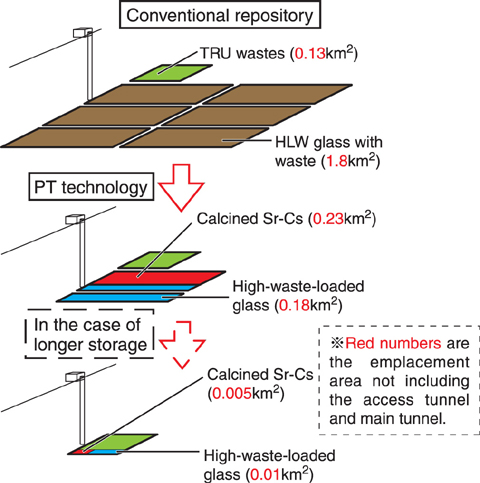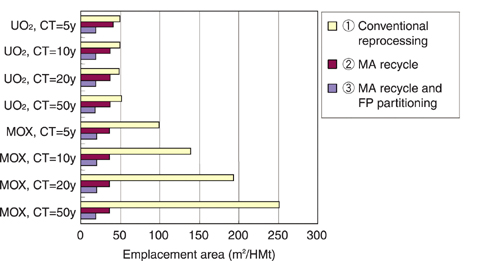
Fig.7-7 Outline of PT technology

Fig.7-8 Reduction of the HLW repository size for HLW, using PT technology

Fig.7-9 The emplacement area of the repository for various spent fuels from light water reactors
In Japan's current policy, the high-level radioactive liquid waste from reprocessing plants is vitrified into glass waste forms and is disposed of deep underground. In the PT technology, minor actinides (MAs), platinum group metals (PGMs), and heat-generating elements (Sr-Cs) are separated from the liquid waste as illustrated in Fig. 7-7. Then, MAs are transmuted by a "transmuter" and PGMs are utilized. An accelerator-driven system or a fast reactor will be employed as the transmuter. Sr-Cs and the remaining elements including metals and rare earths are disposed of underground. We sought to determine rational waste management methods, from the processing to storage and disposal, for these two element groups according to the properties of each group.
The heat-generating elements and the other elements are processed into calcined Sr-Cs waste and glass with high concentrations of waste, respectively. The former generates very high heat and the latter generates very low heat.
If the waste is disposed of in the same type of emplacement configuration as the conventional configuration using glass, the area of the repository will be reduced to one-fourth (Fig.7-8). This is because the calcined Sr-Cs, which tolerates high temperature and is easy to store, is stored for 130 years, and the number of glass pieces is reduced in number from forty thousand to eight thousand by high-waste-loading. Moreover, both waste forms can be very compactly disposed of in an emplacement configuration similar to that of the TRU wastes if longer storage is adopted; 320 years for the calcined Sr-Cs and 45 years for the high-waste-loaded glass.
We also studied the impact of PT technology on the repository size in various cases of spent fuel (Fig.7-9). Note that a large area is required in the case of plutonium fuel due to the accumulation of 241Am when the storage period before reprocessing is prolonged. Even in such case, the repository becomes compact by transmuting the MA. The compact repository achieved by PT technology means the area that had been used for one repository can be used for a longer term.